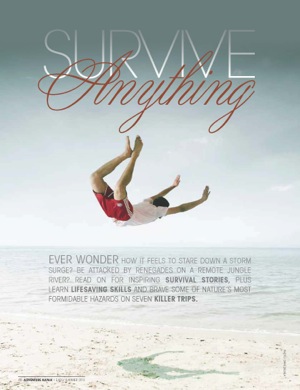What if…? Ever wonder what you’d do if you get lost in the fog without a compass? Or if you become stranded on an ocean isle with no freshwater? What if you become separated from your boat? Get a leg up with these lifesaving survival skills.
What if…
You Need a Rescue
An effective signal can save your life. A whistle or other loud noise can summon help if people are nearby. If not, you must attract visual attention with reflection, color, size or movement. Make a large visual cue that stands out from your immediate environment—spread horizontally if you expect air rescue, vertically if by land or water. Rescuers will look for three of anything, such as smoky fires or piles of driftwood. High-visibility silver and orange survival blankets are inexpensive, compact and especially easy to spot. And remember, always file a float plan in advance with someone who will act if you do not return as scheduled.
Lost without a Compass
Check your map or chart regularly to see if the coast offers any visual cues. If you must travel in fog, use the shore as a handrail, keeping land in sight at all times. To get your bearings, fashion a simple magnetic compass using a thin piece of iron or steel such as a sewing needle or strand of rudder or skeg cable. Magnetize the metal by rubbing in one direction on sheer fabric (try merino or polypro), and float it on a leaf or wood chip in very calm water (use a puddle or bowl). To travel on a bearing, align two objects some distance apart in your desired direction. As you approach the first object, select another behind the second one to stay on course.
Soggy Matches
Starting a fire with a bow drill or flint and steel is straightforward, but you’d do well to practice at home first. Balsam fir resin, birchbark and small pieces of dry cedar turn a tiny flame into a real fire in no time, even in wet and windy conditions. Store your fire kit in a Nalgene or empty peanut butter jar so it’s bone dry when you really need it.
Lightning Strikes
When a thunderstorm approaches, stay off the water. If you must remain on the water, hug the shoreline and keep away from tall, isolated objects like lighthouses or treed islets. On land, avoid hills, caves, rocky summits and the classic lone tree in a field. Seek shelter beneath a canopy of trees with uniform height and squat on a PFD or sleeping pad on the lowest spot. Remember, lightning can strike from as far away as three miles, or 15 seconds between flash and crash.
Dirty Drinking Water
For water with a lot of suspended sediment, fill a container and allow the silt to settle to the bottom overnight. Coffee filters, clean underwear, T-shirts and even sand will also filter out larger particles. Neither of these methods treats “beaver fever” (giardia) so if you’re unable to boil or chemically treat the water, choose your source wisely. Flowing ground water is safest, but may be hard to find. On the bright side, symptoms from the giardia parasite don’t appear for at least seven days, so you can deal with that misery when you get home.
Lost Paddle
Forage for anything flat, light, long and strong, preferably with a comfortable grip. Try driftwood or manmade debris—and take two or three pieces. What feels good standing on a beach may not after 10,000 strokes.
Parched with Nothing to Drink
If you’re pinned on an island in the ocean, your first priority is finding freshwater. Collect dew with your boat sponge or bandanna. And make a solar still: pay careful attention to temperature differences throughout the day—evaporation from a moist surface like a patch of moss or the ocean will rise and condense on a colder collection tent suspended above. Use a garbage bag, tarp, tent fly or paddle jacket; any of these can also be used to catch rainwater.
 To read inspiring survival stories and discover killer kayak trips, check out Adventure Kayak, Summer/Fall 2013. Download our free iPad/iPhone/iPod Touch App or Android App or read it here for free.
To read inspiring survival stories and discover killer kayak trips, check out Adventure Kayak, Summer/Fall 2013. Download our free iPad/iPhone/iPod Touch App or Android App or read it here for free.









 To read inspiring survival stories and discover killer kayak trips, check out Adventure Kayak, Summer/Fall 2013. Download our free
To read inspiring survival stories and discover killer kayak trips, check out Adventure Kayak, Summer/Fall 2013. Download our free 


